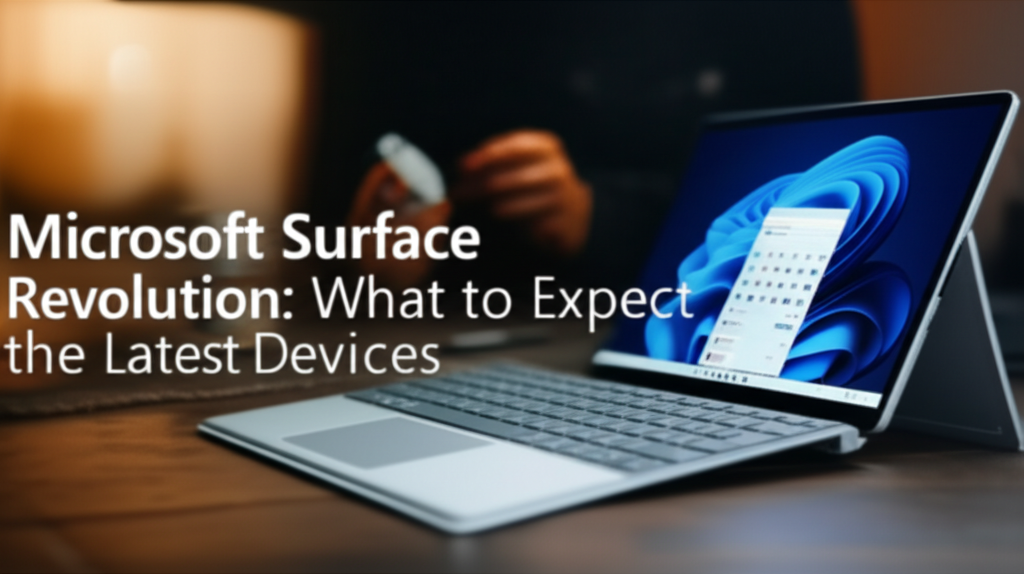Introduction
In the technology landscape, few names resonate as strongly as Microsoft. The company, synonymous with software innovation, has also made significant strides in hardware, particularly with the Microsoft Surface line. The Surface devices have not only altered how individuals interact with technology but have also redefined the expectations for computing innovation. As we look to understand what to expect from the latest Surface devices, it is crucial to contextualize their evolution and the cultural shifts that accompany these advancements.
The Origin of the Surface Series
The Microsoft Surface series was launched in 2012, initially aimed at bridging the gap between tablets and laptops. The original Surface RT and Surface Pro marked a significant departure from traditional PC design, embracing a more portable, touch-centric approach. These devices set the groundwork for ongoing innovations, positioning Microsoft as not only a software provider but also a formidable player in the hardware arena.
Key Innovations
The introduction of key features, such as the detachable keyboard and the kickstand design, showcased Microsoft’s intent to revolutionize personal computing. The Surface Pen, adding a layer of creativity and productivity, further exemplified the company’s commitment to enhancing user experience. Since its inception, the Surface line has evolved through various iterations, each reflecting advancements in technology and user needs.
Cultural Impact and User Adoption
The Microsoft Surface series has not just been about technological advancements; its influence reaches into cultural spheres. The fusion of portability with functionalities akin to traditional laptops has attracted a varied user base, from students to professionals. The introduction of Windows 10 with its touch-friendly interface was a pivotal moment, allowing users to experience an OS that complemented the device’s hardware capabilities.
The Shift in Work Culture
The COVID-19 pandemic accelerated a shift to remote work, prompting many to seek versatile devices that adapt to different environments. Surface devices, with their flexibility and performance, became a popular choice for many. Understanding this societal shift is essential for predicting future developments in Surface devices.
What’s on the Horizon?
As we consider the latest advancements in the Surface range, several key themes emerge that speak to the future direction of tech innovation and user needs.
Advanced Processing Power
The upcoming Surface devices are expected to harness the capabilities of the latest processors. With Intel’s Alder Lake and AMD’s latest offerings, users can anticipate enhanced performance, efficiency, and battery life. This upgrade is critical for professionals who demand robust performance for resource-heavy applications, reinforcing Microsoft’s commitment to professional users.
AI Integration
Artificial intelligence continues to be a game-changer in tech. The integration of AI into Surface devices suggests features like advanced voice recognition, personalized interfaces, and even smart assistance that adapts to user behavior over time. This evolution reflects a broader trend within the tech industry, aiming to create devices that not only respond to commands but anticipate user needs.
Design Innovations
Microsoft has always placed emphasis on design. The upcoming Surface devices are expected to reflect a more refined aesthetic, potentially focusing on sustainable materials that appeal to eco-conscious consumers. The push towards lighter, sleeker designs without compromising functionality could redefine user expectations around portability.
Versatility for Hybrid Work
The growing acceptance of hybrid work models necessitates devices that can transition seamlessly between home and office settings. Surface’s design ethos is likely to evolve further, incorporating features that facilitate this adaptability—be it through modular designs, enhanced connectivity options, or innovative accessory integrations.
Commencing with Windows 11
With the launch of Windows 11, the Surface series stands poised to fully leverage the new OS’s capabilities. The user experience improvements—from revamped UI to better multitasking options—will enhance the functionality of Surface devices, making them even more attractive for a diverse audience. The ecosystem Microsoft is creating hints at the importance of holistic integration between hardware and software.
Accessibility in Technology
Another critical area for the future of Microsoft Surface devices is accessibility. As the tech world becomes more aware of inclusivity, Surface devices are expected to include features that cater to users with disabilities. This might involve improved screen readers, voice commands, and customizable interfaces, ensuring that devices are usable for everyone.
Conclusion: The Future of Microsoft Surface
Looking towards the future, the Microsoft Surface series will likely continue to set benchmarks for innovation in personal computing. By capitalizing on advancements in processing technology, AI integration, design, and user inclusivity, Microsoft aims to craft devices that are not only functional but also resonate with the evolving needs of users worldwide.
The legacy of Surface goes beyond mere hardware; it embodies a vision of how technology can enhance productivity and creativity in a rapidly changing world. As we await the latest iterations, one thing is clear: the Microsoft Surface revolution is far from over, and its impact will continue to shape the technology landscape for years to come.
This anticipation marks an exciting journey not only for Microsoft but for its users who rely on purposeful design and cutting-edge technology to sculpt their digital experiences in an increasingly interconnected world.

